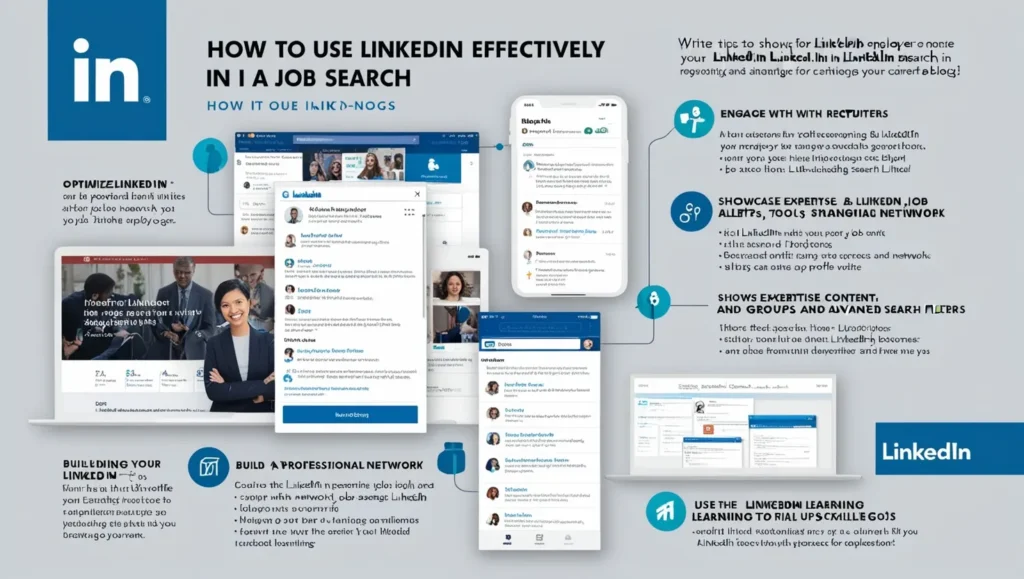How to Use LinkedIn Effectively in Your Job Search
LinkedIn has become an indispensable tool for job seekers in the digital age. With over 900 million professionals using the platform worldwide, it offers unparalleled opportunities to network, build your personal brand, and land your dream job. However, simply having a profile isn’t enough—you need to know how to leverage LinkedIn effectively. Here’s a comprehensive guide to making the most of LinkedIn in your job search.
1. Optimize Your LinkedIn Profile
Your LinkedIn profile is your digital resume and professional identity. To attract recruiters and hiring managers, ensure your profile is polished and complete.
- Professional Headline: Craft a concise yet impactful headline that reflects your expertise or career goals (e.g., “Marketing Specialist | Content Creator | SEO Enthusiast”).
- Profile Picture: Use a high-quality, professional headshot that aligns with your industry.
- Custom URL: Personalize your LinkedIn URL (e.g., linkedin.com/in/yourname) to make it easy to share.
- Summary Section: Write a compelling summary that highlights your skills, achievements, and career aspirations. Use keywords relevant to your target roles.
- Skills and Endorsements: List your skills and request endorsements from colleagues or supervisors. These act as social proof of your expertise.
- Experience: Detail your work experience with quantifiable results (e.g., “Increased sales by 30% in 6 months”)
- Education and Certifications: Include all relevant qualifications, certifications, and licenses.
2. Build a Strong Network
Networking is at the heart of LinkedIn’s power. The more meaningful connections you have, the wider your reach.
- Start with People You Know: Connect with former colleagues, classmates, mentors, and friends.
- Expand to Industry Professionals: Search for and connect with people in your field, especially those at companies you’re interested in.
- Personalize Connection Requests: Always include a short, polite message when sending connection requests (e.g., “Hi [Name], I admire your work in [specific area]. I’d love to connect and learn more about your experiences.”).
- Engage with Your Network: Comment on posts, share relevant articles, and participate in discussions to stay visible and build relationships.
3. Leverage LinkedIn Job Search Tools
LinkedIn’s job search features make it easy to find opportunities tailored to your skills and interests.
- Use Advanced Search Filters: Filter job postings by location, industry, job function, and experience level.
- Set Up Job Alerts: Save your search criteria and turn on alerts to receive notifications for new postings.
- Apply with Your Profile: Many job postings allow you to apply directly using your LinkedIn profile. Ensure your profile aligns with the job requirements.
- Track Saved Jobs: Keep track of positions you’re interested in by saving them for future reference.
4. Join and Participate in LinkedIn Groups
LinkedIn Groups are hubs for professionals with shared interests. They offer excellent opportunities for networking and industry insights.
- Find Relevant Groups: Search for groups related to your industry, profession, or job interests.
- Be Active: Share articles, comment on discussions, and ask thoughtful questions to showcase your expertise.
- Network Within Groups: Connect with other members by engaging with their content or sending personalized messages.
5. Showcase Your Expertise Through Content
Building your personal brand on LinkedIn can make you stand out to recruiters and industry professionals.
- Share Industry Insights: Post articles, reports, or updates relevant to your field.
- Write Thought Leadership Posts: Share your perspective on industry trends or challenges.
- Use Visuals: Include images, videos, or infographics to make your posts more engaging.
- Engage With Others’ Content: Comment, like, and share posts to build relationships and increase your visibility.
6. Research Companies and Recruiters
LinkedIn is an excellent tool for researching potential employers and connecting with recruiters.
- Follow Target Companies: Stay updated on their news, job openings, and company culture.
- Identify Key Decision-Makers: Use LinkedIn to find and connect with hiring managers or team leads.
- Engage With Recruiters: Reach out to recruiters who specialize in your field, but personalize your message to make it relevant and professional.
7. Request Recommendations
Recommendations from colleagues or supervisors add credibility to your profile.
- Ask Strategically: Request recommendations from people who can vouch for your skills and work ethic.
- Be Specific: Mention the skills or projects you’d like them to highlight in their recommendation.
- Reciprocate: Offer to write recommendations for others—it’s a great way to strengthen professional relationships.
8. Use LinkedIn Learning
LinkedIn offers an extensive library of online courses to help you upskill.
- Identify Gaps: Focus on learning skills that are in high demand in your target industry.
- Showcase Certifications: Add completed courses to your profile to demonstrate your commitment to continuous learning.
9. Engage With Recruiters Effectively
When reaching out to recruiters, be polite, concise, and professional.
- Craft a Strong Introduction: Mention your skills, experience, and what you’re looking for in a role.
- Highlight Mutual Connections: Reference shared contacts or groups to establish common ground.
- Be Proactive: Follow up politely if you don’t hear back, but avoid being overly persistent.
10. Monitor Your Activity and Analytics
LinkedIn provides tools to track your profile views and post engagement. Use these insights to refine your strategy.
- Profile Views: Check who’s viewing your profile and reach out if relevant.
- Content Engagement: Analyze which posts perform best and tailor your content accordingly
Final Thoughts
LinkedIn is more than just a professional networking site—it’s a powerful tool to supercharge your job search. By optimizing your profile, building meaningful connections, showcasing your expertise, and leveraging LinkedIn’s tools, you can position yourself as a standout candidate in the competitive job market.
Consistency and genuine engagement are key. Treat LinkedIn as an active part of your job search strategy, and you’ll not only find opportunities but also build lasting professional relationships that benefit your career for years to come.

